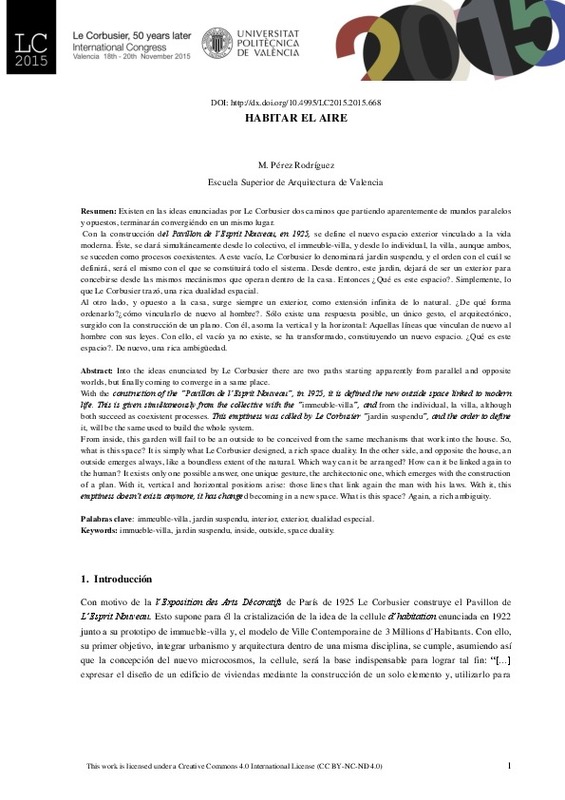JavaScript is disabled for your browser. Some features of this site may not work without it.
Buscar en RiuNet
Listar
Mi cuenta
Estadísticas
Ayuda RiuNet
Admin. UPV
HABITAR EL AIRE
Mostrar el registro sencillo del ítem
Ficheros en el ítem
| dc.contributor.author | Perez Rodriguez, Marta
|
es_ES |
| dc.date.accessioned | 2018-02-09T07:19:21Z | |
| dc.date.available | 2018-02-09T07:19:21Z | |
| dc.date.issued | 2016-03-03 | |
| dc.identifier.isbn | 9788490483732 | |
| dc.identifier.uri | http://hdl.handle.net/10251/97542 | |
| dc.description.abstract | [EN] Into the ideas enunciated by Le Corbusier there are two paths starting apparently from parallel and opposite worlds, but finally coming to converge in a same place. With the construction of the “Pavillon de l’Esprit Nouveau”, in 1925, it is defined the new outside space linked to modern life. This is given simultaneously from the collective with the “immeuble-villa”, and from the individual, la villa, although both succeed as coexistent processes. This emptiness was called by Le Corbusier “jardin suspendu”, and the order to define it, will be the same used to build the whole system. From inside, this garden will fail to be an outside to be conceived from the same mechanisms that work into the house. So, what is this space? It is simply what Le Corbusier designed, a rich space duality. In the other side, and opposite the house, an outside emerges always, like a boundless extent of the natural. Which way can it be arranged? How can it be linked again to the human? It exists only one possible answer, one unique gesture, the architectonic one, which emerges with the construction of a plan. With it, vertical and horizontal positions arise: those lines that link again the man with his laws. With it, this emptiness doesn’t exists anymore, it has changed becoming in a new space. What is this space? Again, a rich ambiguity. | es_ES |
| dc.description.abstract | [ES] Existen en las ideas enunciadas por Le Corbusier dos caminos que partiendo aparentemente de mundos paralelos y opuestos, terminarán convergiéndo en un mismo lugar. Con la construcción del Pavillon de l’Esprit Nouveau, en 1925, se define el nuevo espacio exterior vinculado a la vida moderna. Éste, se dará simultáneamente desde lo colectivo, el immeuble-villa, y desde lo individual, la villa, aunque ambos, se suceden como procesos coexistentes. A este vacío, Le Corbusier lo denominará jardin suspendu, y el orden con el cuál se definirá, será el mismo con el que se constituirá todo el sistema. Desde dentro, este jardin, dejará de ser un exterior para concebirse desde las mismos mecánismos que operan dentro de la casa. Entonces ¿Qué es este espacio?. Simplemente, lo que Le Corbusier trazó, una rica dualidad espacial. Al otro lado, y opuesto a la casa, surge siempre un exterior, como extensión infinita de lo natural. ¿De qué forma ordenarlo?¿cómo vincularlo de nuevo al hombre?. Sólo existe una respuesta posible, un único gesto, el arquitectónico, surgido con la construcción de un plano. Con él, asoma la vertical y la horizontal: Aquellas líneas que vinculan de nuevo al hombre con sus leyes. Con ello, el vacío ya no existe, se ha transformado, constituyendo un nuevo espacio. ¿Qué es este espacio?. De nuevo, una rica ambigüedad. | es_ES |
| dc.format.extent | 20 | es_ES |
| dc.language | Español | es_ES |
| dc.publisher | Editorial Universitat Politècnica de València | es_ES |
| dc.relation.ispartof | LE CORBUSIER. 50 AÑOS DESPUÉS | es_ES |
| dc.rights | Reconocimiento - No comercial - Sin obra derivada (by-nc-nd) | es_ES |
| dc.subject | Immeuble-villa | es_ES |
| dc.subject | Jardin suspendu | es_ES |
| dc.subject | Interior | es_ES |
| dc.subject | Exterior | es_ES |
| dc.subject | Dualidad especial | es_ES |
| dc.subject | Architecture | |
| dc.subject | Le Corbusier | |
| dc.subject | Modern movement | |
| dc.subject.classification | PROYECTOS ARQUITECTONICOS | es_ES |
| dc.title | HABITAR EL AIRE | es_ES |
| dc.type | Capítulo de libro | es_ES |
| dc.type | Comunicación en congreso | es_ES |
| dc.identifier.doi | 10.4995/LC2015.2015.668 | |
| dc.rights.accessRights | Abierto | es_ES |
| dc.contributor.affiliation | Universitat Politècnica de València. Departamento de Proyectos Arquitectónicos - Departament de Projectes Arquitectònics | es_ES |
| dc.contributor.affiliation | Universitat Politècnica de València. Escuela Técnica Superior de Arquitectura - Escola Tècnica Superior d'Arquitectura | es_ES |
| dc.description.bibliographicCitation | Perez Rodriguez, M. (2016). HABITAR EL AIRE. En LE CORBUSIER. 50 AÑOS DESPUÉS. Editorial Universitat Politècnica de València. 1665-1684. https://doi.org/10.4995/LC2015.2015.668 | es_ES |
| dc.description.accrualMethod | OCS | es_ES |
| dc.relation.conferencename | LC2015 - Le Corbusier, 50 years later | es_ES |
| dc.relation.conferencedate | November 18-20,2015 | es_ES |
| dc.relation.conferenceplace | Valencia, Spain | es_ES |
| dc.relation.publisherversion | http://ocs.editorial.upv.es/index.php/LC2015/LC2015/paper/view/668 | es_ES |
| dc.description.upvformatpinicio | 1665 | es_ES |
| dc.description.upvformatpfin | 1684 | es_ES |
| dc.type.version | info:eu-repo/semantics/publishedVersion | es_ES |
| dc.relation.pasarela | OCS\668 | es_ES |








